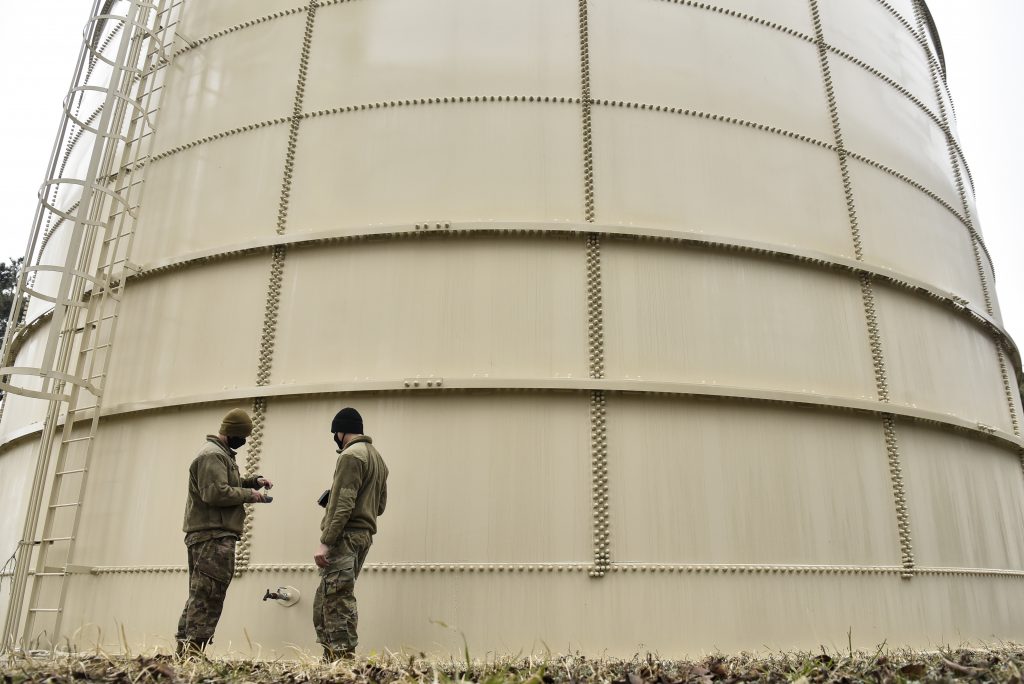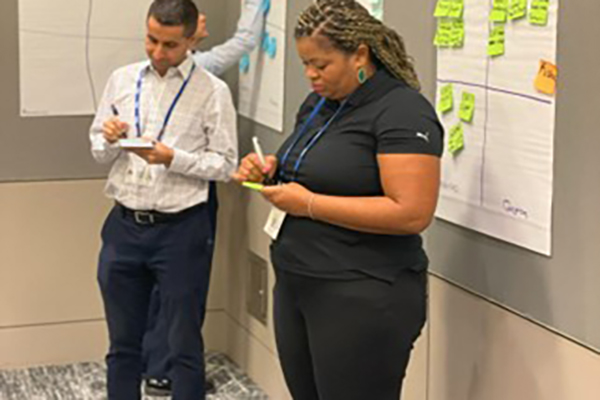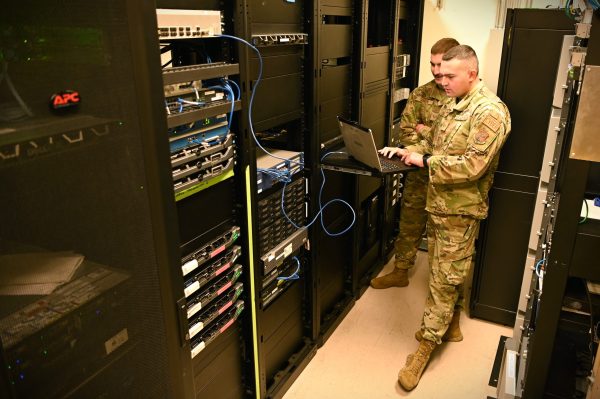By Capt. Bethany Dorian, P.E., M.SAME, USAF, Capt. Takayuki Iguchi, Ph.D., USAF, Maj. Chancellor Johnstone, Ph.D., USAF, and Christopher Chini, Ph.D.
A look at water pipes across the U.S. Air Force shows an aging system with a general trend of decreasing condition with age. The pipes are, on average, 33 years old. In fact, 25 percent of the water pipes are 63 years or older, indicating a significant portion of pipes are reaching the end of their design life. Any management system for water distribution pipes must have robust statistical forecasting methods able to incorporate a wide array of data across the enterprise.
A study conducted by the Air Force Institute of Technology (AFIT) examined the Air Force’s water distribution systems to illustrate the need for enhanced prediction capabilities in any sustainment management system.

TARGETING INVESTMENTS
To better monitor water distribution systems, sustainment management systems should be able to account for uncertainty, update projections with new data, and provide additional support for investment decision-making.
In 2019, the Secretary of the Air Force published the Infrastructure Investment Strategy, promoting greater investments in infrastructure assets for improving resilience and condition. The strategy seeks to increase the infrastructure budget to 2 percent of replacement value, annually. A total of three lines of effort are proposed to advance infrastructure investment, including cost-effective modernization of infrastructure. Specifically, the strategy promotes proactive spending to drive down lifecycle infrastructure costs by prioritizing the repair of mission-critical infrastructure.
Linear assets are an important component of this investment strategy. However, with roughly 15 percent of pipes on Air Force installations currently labeled as failing and a majority of pipes in a “fair” category, there is a significant challenge to determine where to invest resources.
As part of the AFIT study, water mains were broken down by material, condition, and size. Condition assessment of linear assets are evaluated across three categories: green (good condition), amber (fair), and red (failing). While a majority of pipes in the red category are of moderate size (diameter between 4-in and 10-in), a significant portion of failing pipes have diameters greater than 12-in. Therefore, with diameter as a surrogate for importance, we could begin to invest in larger pipes first, in order to gain the largest return on investment with limited annual funding. However, this deterministic approach has significant variability in its potential effect and lacks nuance of assessing variable funding levels, the interconnection of pipes, and uncertainty in asset deterioration.
MANAGING ASSETS, EFFECTIVELY
For the last decade, Air Force civil engineers have focused on asset management, with the overarching goal of ensuring infrastructure support for base operations at a minimized lifecycle cost and with management of the risk of failure.
Strong asset management is predicated on data collection across a variety of assets including facilities, roads, runways, pipes, and electric lines. Data systems, such as BUILDER (introduced in 2013), GeoBase, and TRIRIGA are critical tools that help organize and hold information about the assets on installations. These systems are supported by institutional business rules and training that instruct engineers how to input, manage, and update data, and how to use the data when making sustainment and investment decisions. Facilities and their subsystems have clearly defined requirements for recurring inspections. However, as systems are developed for the management of linear assets, including water, sanitary sewer, storm drainage, and electric distribution, it is important to incorporate advanced techniques based on the lessons learned from previous sustainment management systems.
Specifically, linear asset management systems should be able to project condition with uncertainty, update predictions as new data are obtained, and provide reliable decision support for investment strategies.
UNCERTAIN CONDITIONS
A challenge with inspecting water systems is that they are predominantly underground. Lack of visibility makes routine inspections expensive and infeasible. Additionally, many components of the system have lifespans of multiple decades, which makes it challenging to know when to inspect, repair, or replace. Completing inspections with specialized equipment to get quality condition data at the right time is crucial to maximize the value.
The nature of these systems increases the value of using larger-scale statistical and machine learning models, which can “learn” from data in specific locations and apply the principles across the enterprise with some level of confidence. These projections naturally come with uncertainty, which requires a system capable of handling and managing that uncertainty within the context of decision-making. The existing rules of when to inspect, how to inspect, and how to evaluate the importance of facilities are not the same as those for linear assets, particularly underground assets.
BUILDER has several weaknesses that should be addressed in future systems. Namely, it is unable to incorporate multiple time-based condition assessments for the same asset into a predictive model and unable to forecast condition with multiple characteristics. Currently, BUILDER uses a deterministic, single projection of condition based on expected service life and age. With over 10 years of inspections conducted, the five-year inspection cycle has occurred enough for multiple condition data points on the same subcomponents. However, the BUILDER condition forecast does not update its projections with the addition of new or accumulated observations.
Additionally, facility asset condition is assessed using a 0 to 100 rating scale. With the onset of robust computer models for asset management that include methods using both machine learning and statistical models on location-based parameters, there are a multitude of opportunities to incorporate new and better approaches for condition forecasting. Rating asset condition from 0 to 100 is unsuitable for a categorical assessment without an arbitrary choice of bins.
Finally, newer statistical tools offer the ability to update projections and the state of the system more reflexively— providing a stronger decision-making tool for short-, medium-, and long-term investment strategies. New sustainment systems should incorporate these technological advancements to update condition projections based on real-world assessments over time.
TOOLS FOR THE FUTURE
With the current completion of Air Force-wide segmentation for asset inventory, current efforts are aimed at business rules for project validation and funding. A detailed look is needed to make fundamental improvements to future sustainment management systems and serve civil engineers for the next 30 years.
The Department of Systems Engineering & Management at AFIT, in collaboration with the U.S. Army Corps of Engineers, is investigating these issues to develop better models that incorporate uncertainty and new data with three expected outcomes:
- Probabilistic Markov Chain models using Air Force data to predict changes in condition of water mains over time based on individual asset properties.
- Simulation of investment strategies to sustain or improve condition of water mains over time based on mission importance.
- Assessment of the variability of funding levels and its impact on long-term system conditions.
The span of water distribution in the Air Force is complex and vast. The management of linear assets through inventory, condition, and investment decisions needs more capable, flexible tools.
Capt. Bethany Dorian, P.E., M.SAME, USAF, is Graduate Student, Capt. Takayuki Iguchi, Ph.D., USAF, is Assistant Professor, Maj. Chancellor Johnstone, Ph.D., USAF, is Assistant Professor, and Christopher Chini, Ph.D., is Assistant Professor, Air Force Institute of Technology. They can be reached at bethany.dorian.1@us.af.mil; takayuki.ig1@us.af.mil; chancellor.johnstone.1@us.af.mil; and christopher.chini.1@au.af.edu.
More News from TME
-

Fulfilling the Mission
Rear Adm. Dean VanderLey, CEC, USN, Commander, Naval Facilities Engineering Systems Command, sits down with TME to discuss the Department of the Navy’s Systems Command for shore facilities and expeditionary equipment, Naval Facilities Engineering Systems Command (NAVFAC) and its varied responsibility that directly support warfighter lethality. -

Strengthening Installation Energy Resilience Through a Community of Practice
The Military Energy Resilience Catalyst strengthens installation energy resilience by providing opportunities for energy practitioners to develop professionally and connect with experts, senior leaders, and colleagues. -

Developing an Engineering Standard of Care for Cyber Safety
There is growing urgency to secure the nation’s critical infrastructure from a cyberattack, which will require improvements in both federal policies and day-to-day operations to strengthen response and recovery from incidents.